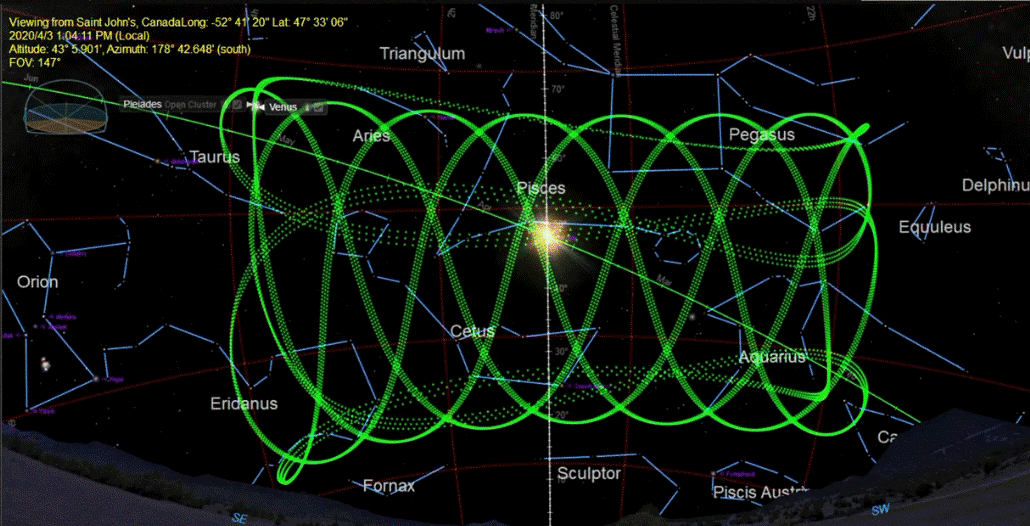There is an upcoming event in the evening sky that is worth notifying your colleagues about on social media this week. Venus is going to pass in front of the Pleiades star cluster on Friday, April 3rd. The neat thing about it is that this happens every 8 years, to the day. You can simulate it on SciDome in Starry Night.
Venus is the brightest object in the evening sky other than the Moon this month, and it is provoking lots of UFO reports. Venus is also getting closer to Earth, so its apparent size is growing. Venus is also starting to turn into a crescent as it gets between the Earth and the Sun. It is a fascinating object to observe through small binoculars, especially when the Pleiades are also visible in the same binocular field of view.
Venus orbits the Sun every 225 days, but the Earth orbits the Sun as well, and it takes more than a year for Venus to catch up to the Earth and pass us. Venus returns to the same position with respect to the Earth every 8/5ths (or 1.6) of a year, or 584 days. Because it’s not equal to a year, when Venus returns after 584 days, it’s not in position against the same background stars. However, the lowest integer multiple of 1.6 is 8, so Venus does appear against the same background stars on the date when it passes the Earth every 8 years (although a backwards drift of 2 days per 8 years accumulates.)
We’re familiar with the analemma, the figure-8 pattern the Sun draws on the sky if you animate Starry Night forward in steps of 1 day at noon. Venus also has an analemma, but it’s a spirograph pattern instead of a figure-8 because its Synodic period repeats five times over the course of those 8 years. This spirograph pattern of Venus’s Local Path at 1-day intervals in Starry Night is really cool.

The Synodic Period of Venus is covered in depth in David Bradstreet’s Fulldome Curriculum Vol. 3 minilesson “Synodic Period of Venus”.
The Pleiades is the brightest star cluster that happens to be on the Ecliptic plane, so it can periodically be occulted by the Moon, and the planets sometimes pass through it. Venus passes by the Pleiades every 8/5ths of a year too, although sometimes it passes by when the Pleiades is near the Sun in May, and sometimes when the Pleiades is in the predawn sky in late summer, and sometimes it passes by the Pleiades twice because it has a retrograde loop. The accumulating 2-day error also means that Venus’s path through the Pleiades is never quite the same with each 8-year interval, and the event is a coincidence that doesn’t look so perfect if you dial it back way into the past, or well into the future. But different dates become prominent for Venus meeting the Pleiades instead.
Venus’s greatest meeting in the sky is the Transit of Venus across the face of the Sun, which is very rare, and the Transit of Venus is also affected by that accumulating drift. Venus was in front of the Sun on June 8th, 2004 and again on June 6th, 2012, but another Transit will not happen again on June 4th, 2020 (but it will be close!) The next Transit of Venus will be on December 10th, 2117.
The first time I observed Venus in the Pleiades was on April 3rd, 1996, and I recommend you look up that date in Starry Night especially. Also on that date in the evening there was a total lunar eclipse in the eastern sky, and also the bright Comet Hyakutake was in the western sky just a few degrees away from the Pleiades.
So please make your community aware of the coincidence of Venus and the Pleiades this week, so they can look up again on April 3rd of 2028 and remember what they were doing 8 years earlier.
